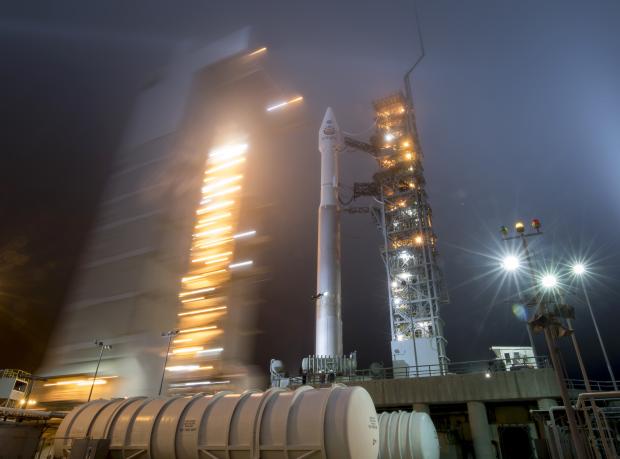
In this photo released by NASA, the mobile service tower at SLC-3 is rolled back to reveal the United Launch Alliance (ULA) Atlas-V rocket with NASA’s InSight spacecraft onboard, Friday, May 4, 2018, at Vandenberg Air Force Base in California. The rocket was launched Saturday, May 5, 2018. (Photo by BILL INGALLS / NASA via AP)
CAPE CANAVERAL, Florida — A robotic geologist armed with a hammer and quake monitor rocketed toward Mars on Saturday, aiming to land on the red planet and explore its mysterious insides.
In a twist, NASA launched the Mars InSight lander from California rather than Florida’s Cape Canaveral. It was the first interplanetary mission ever to depart from the West Coast, drawing pre-dawn crowds to fog-socked Vandenberg Air Force Base and rocket watchers down the California coast into Baja.
“This is a big day. We’re going back to Mars!” said NASA’s new boss, Jim Bridenstine. “This is an extraordinary mission with a whole host of firsts.” The spacecraft will take more than six months to get to Mars and start its unprecedented geologic excavations, traveling 300 million miles (485 million kilometers) to get there.
InSight will dig deeper into Mars than ever before – nearly 16 feet, or 5 meters – to take the planet’s temperature. It will also attempt to make the first measurements of marsquakes, using a high-tech seismometer placed directly on the Martian surface.
The Atlas V rocket also gave a lift to a pair of mini test satellites, or CubeSats, meant to trail InSight all the way to Mars and then serve as a potential communication link. They popped off the rocket’s upper stage in hot pursuit of InSight, as elated launch controllers applauded and shook hands following the morning’s success.
The $1 billion mission involves scientists from the U.S., France, Germany and elsewhere in Europe.
NASA hasn’t put a spacecraft down on Mars since the Curiosity rover in 2012. The US, in fact, is the only country to successfully land and operate a spacecraft at Mars. It’s tough, complicated stuff. Only about 40 percent of all missions to Mars from all countries – orbiters and landers alike – have proven successful over the decades.
If all goes well, the three-legged InSight will descend by parachute and engine firings onto a flat equatorial region of Mars – believed to be free of big, potentially dangerous rocks – on Nov. 26. Once down, it will stay put, using a mechanical arm to place the science instruments on the surface.
“This mission will probe the interior of another terrestrial planet, giving us an idea of the size of the core, the mantle, the crust and our ability then to compare that with the Earth,” said NASA’s chief scientist Jim Green. “This is of fundamental importance to understand the origin of our solar system and how it became the way it is today.”
InSight’s principal scientist, Bruce Banerdt of NASA’s Jet Propulsion Laboratory in Pasadena, California, said Mars is ideal for learning how the rocky planets of our solar system formed 4.5 billion years ago. Unlike our active Earth, Mars hasn’t been transformed by plate tectonics and other processes, he noted.
Over the course of two Earth years – or one Martian year – scientists expect InSight’s three main experiments to provide a true 3-D image of the interior of Mars.
The lander is equipped with a seismometer for measuring marsquakes, a self-hammering probe for burrowing beneath the surface, and a radio system for tracking the spacecraft’s position and planet’s wobbly rotation, thereby revealing the size and composition of Mars’ core.
“InSight, for seismologists, will really be a piece of history, a new page of history,” said the Paris Institute of Earth Physics’ Philippe Lognonne, lead scientist of the InSight seismometer.
Problems with the French-supplied seismometer kept InSight from launching two years ago. California was always part of the plan.
NASA normally launches from Cape Canaveral, but decided to switch to California for InSight to take advantage of a shorter flight backlog. This was the first US interplanetary mission to launch from somewhere other than Cape Canaveral.
It was so foggy at Vandenberg that spectators there could hear and feel the roar and rumble of the rocket, but couldn’t see it. It was a marvelous sight, though, farther south. The rocket’s bright orange flame was visible for some time as it arced upward across the dark sky west of greater Los Angeles.
Not even two weeks on the job, NASA’s new administrator, Bridenstine, observed the launch on monitors at space agency headquarters in Washington.
“I can’t think of a better way to start my day!” Bridenstine tweeted.